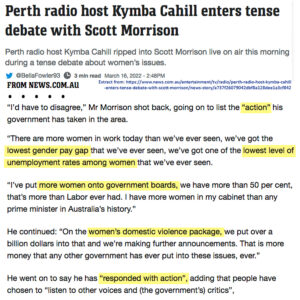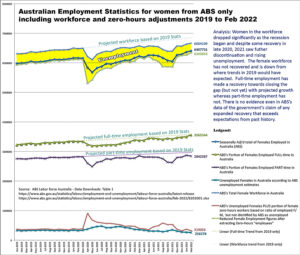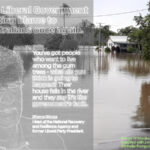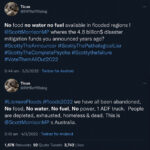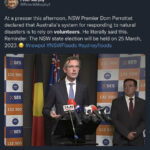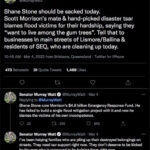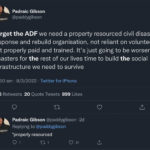Josh Frydenberg is spruiking the coalition’s accomplishments claiming, “Our Govt’s economic plan to create more jobs is working”. However, his statistics based on these claims crumble under scrutiny.
In essence, there are five claims he tweeted recently.
- Unemployment has dropped to 4% in Feb,
- 77k jobs created
- The participation rate is at a record high
- Female unemployment is at a 48 yr low of 3.8%
- 375k more Aussies in work than pre-COVID
Real Unemployment
Despite an attitude of incredulity at the idea that we have such a trim level of unemployment, Josh boasted of unemployment being “the equal lowest in 48 years”. The government is very proud of its apparent economic credentials. So are we to believe that unemployment is the lowest in years with, ascending rental rates and the cost of living, escalating petrol prices, but for obvious reasons wages are stagnating? ABS reported seasonally adjusted unemployment approaching this figure, last in August 2008 (4.1%) and February 2008 (4.0%). So 48 years ago Josh? My maths is not what it used to be.
So employment is better now, only a couple of years out from cataclysmic bushfires that caused over $100B in damages amid a continuing pandemic and massive floods damages? We are also just out of a politically recognised “drop-in-real-GDP” recession but still in the per capita recession that began in mid-2018 (acknowledged in 2019) and showed no real prospect of improvement. Does anything about our Economy ring right?
ABS’s absent considerations
Cracks are showing when it comes to the ABS unemployment statistics, which the government is quoting ad nauseam. Social media is replete with scepticism. There is a lack of credibility in employment stats when one hour’s work represents employment. It is not one hour a week; as they review the previous three weeks from your reference week. Go read my June 2020 article titled “Unemployment by COVID exploded” under the subheading “6.2%? Really?” for the explanation.
The issue is not just the one-hour criteria. It is the zero-hours criteria that should also concern you. People in the Gig economy who have been given zero hours and zero pay should not be considered employed. Yet that is precisely what ABS does for reasons that have nothing to do with it being a measure of domestic internal unemployment. The ABS states: “The term ‘labour force’, as defined by the International Labour Organisation (ILO) in the international standards, is associated with a particular approach to the measurement of employment and unemployment.”
International or Domestic terminal
ABS follows the ILO methodology measures, for international comparative purposes. The methodology was never designed to measure the domestically internal unemployment of any country, because it excludes too many people. The integrity of a domestic measure of unemployment has to be questioned if, for example, it discounts the numbers of people just because they work in the Gig economy under zero-hour contracts. Gig workers are still counted as employed by the ABS even when given zero hours and zero pay.
Every other measure of unemployment is far larger than the ABS’s measure. Still, people are largely unaware of the size of the alternate and more accurate measurements of domestic employment. It is not merely that adding the 130,800 people on zero-hours to the ABS measure of 563,300 unemployed – for international comparative purposes – would raise the 4.04% figure for global comparison to 694,100 or 4.98%. There are more extensive assessments. For example, the sheer number of JobSeeker stats has only recently dropped just below a million people.
At 949,937 people on Jobseeker in February – a number Josh Frydenberg has demonstrated familiarity with – it stretches credibility that 949K versus 563K are simply relegated to margins of error.
Beyond these numbers, there are the estimations made by Roy Morgan, which indicate that 1,227,000 people were unemployed in February 2022. ABS and Roy Morgan’s unemployment figures are estimates based on surveys. At the very least, Jobseeker is a hard count of people receiving a benefit. To review the history of all these numbers, post-recession, I have charted them in Fig 1.
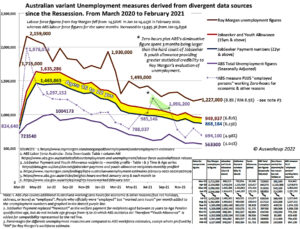
Crossing lines
My reasoning for choosing any measure requires accepting the reasonable postulate, that any internal measure of unemployment should minimally accept that people who have worked zero hours should be included as unemployed. ABS does account for zero-hours workers. So if the current ABS figure and zero-hours workers were added together over the last two years, the graph reveals an interesting anomaly. There are two periods in which that combination exceeds the value of JobSeeker, and that is why Jobseeker by itself – although a hard count – does not represent domestic unemployment numbers.
The combination of ABS unemployment plus Zero-hours numbers exceeded the Jobseeker numbers twice in the last two years. The first occurred in April 2020, and then again for the three months from August to October 2021. Now the first one, to be fair, is at the recession’s start, and it is reasonable to ascribe that to the chaos of the time and errors in measurements. I have previously pointed out how often ABS altered at random intervals their unemployment measures reflecting much uncertainty in my aforementioned June 2020 article. But a sustained series of measures over three months draws different conclusions in a calmer time.
It indicates the absolutely unemployed with not even an hour of work for each month exceeded the Jobseeker’s hard count. However, that anomaly doesn’t factor in all the other reasons ABS undercounts people as unemployed, such as:
- exclusions for unpaid work in a family business, or paid busking or street vending;
- exclusions of short-term foreign workers through the 12/16 rule;
- exclusions of persons unable to take up immediate work;
- hiding unemployment via the government PaTH program;
So what measurement methodology addresses these weaknesses and exclusions?
Answer: Roy Morgan’s employment and unemployment estimates!
Now the reasons for the gap between Jobseeker and Roy Morgan I previously explained in my article titled “Frydenberg’s maths problem”. So what does Roy Morgan show us regarding underemployment and unemployment? What does either ABS’s quarterly measure of Job vacancies or the Department of Employment’s monthly measure of internet Job vacancies tell us about the jobs available for folks looking for work?
The graph of those figures [Fig 2] shows the harsh reality of a paucity of job opportunities and a frightening level of underemployment and unemployment. But, unfortunately, this government has done little to rectify that plight. Frankly, when you consider their dismissal of the public service and their deliberate undermining of manufacturing, it has simply exacerbated the situation.
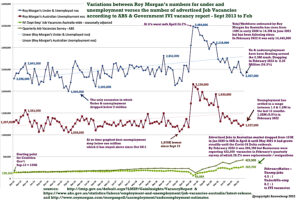
Solutions and reassessments
There are solutions to the unemployment crisis, such as a Federal Job Guarantee. However, there is a complete ideological unwillingness to implement such solutions because it would end wage stagnation. The private sector would have to compete with the government for workers by offering better wages and conditions.
So what does Roy Morgan say is the truth compared to Josh Frydenberg’s list of accomplishments with which we started?
- Unemployment has risen to 8.5% in Feb an increase of 26,000 from January,
- Employment fell by 163,000 to 13,216,000 in February, driven by a fall in part-time employment
- The workforce dropped 137,000 in February
- Female unemployment is also at 8.5% despite being a smaller proportion of the workforce [see Fig 3]
- Employment is 344,000 higher than it was pre-COVID-19 (13,216,000 – 12,872,000).
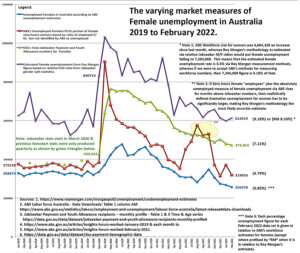
The conclusion about Frydenberg’s claims leaves us with two options. That the man delivering the budget for the whole of the Australian economy has either
- no idea what the actual state of the economy is, or
- is a _ _ _ _ (well, I don’t want to be the one to say it – these guys are litigious, and I can’t afford it.)
